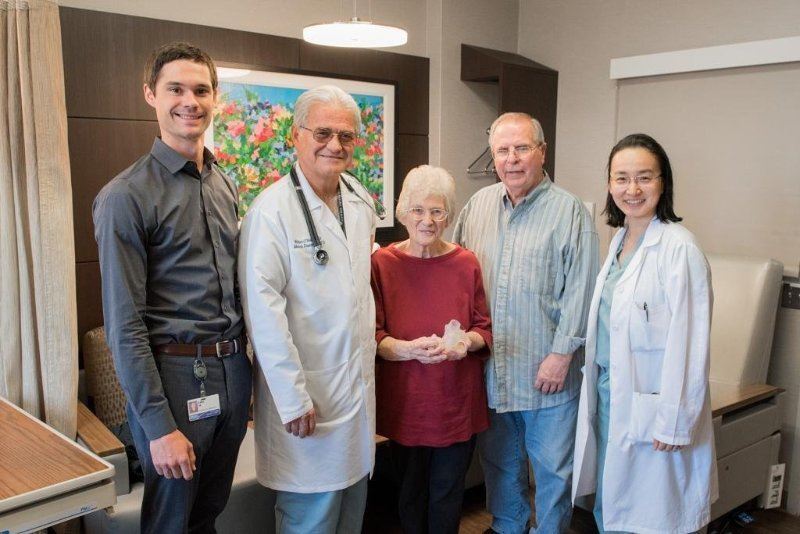![Myers, Dr. O’Neill, and Dr. Wang of the HFHS medical team with their 1,000th patient and her 3D printed heart [Image: HFHS]](https://fabbaloo.com/wp-content/uploads/2020/05/hfhs_img_5eb0993ebeb91.jpg)
Henry Ford Health Systems has brought 3D printing into 1,000 patients’ cardiac treatments.
Medical 3D printing encompasses a variety of application areas: models, guides, implants, bioprinting. It’s the first of these, medical models, that HFHS has great focus.
I first met Dr. Dee Dee Wang, a cardiologist, imaging expert, and Medical Director of 3D Printing at Henry Ford Innovations, a few years ago at Materialise World Summit. There, she spoke to her experiences working with “the sickest of the sick patients” who require cardiac attention but for one reason or another aren’t the best candidates for open heart surgery.
Later that summer, I visited Dr. Wang’s office at HFHS and appreciated the opportunity to see her large collection of hundreds of 3D printed patient hearts, as well as the innovation lab where the team uses Materialise software and several 3D printers to create patient-specific models.
The team has recently announced that it has officially treated 1,000 patients using its 3D printing solutions.
That thousandth patient was 72-year-old Michigander Lillian Keavey, who was in need of a new mitral valve. Rather than another open heart surgery (“I wasn’t looking forward to that,” said Keavey) and its three-month recovery period, the team was able to help her with positioning a new mitral valve in a less invasive procedure — with just a two-week recovery.
The procedure, performed on March 27, brought the HFHS team together five years after their first foray into cardiac 3D printing. The milestone procedure was shared in a live broadcast with the Scottsdale Interventional Forum, where around 400 interventional cardiologists could observe.
“Dr. Wang and I developed this program five years ago, and now we’re at the 1000th patient. I’m very proud of that. I’m so glad we’ve been able to help so many people,” said Eric Myers, Product Designer and Technical Director for 3D Printing at Henry Ford Innovations.
The program has clearly expanded since its inception, and HFHS now uses 3D printing in a variety of applications. Myers notes cardiology, vascular aneurysm planning, oncology planning, cranial-facial reconstruction, and orthopedics uses. Marianne Rollet, Imaging Operations Coordinator at Henry Ford’s Center for Structural Heart Disease, works on the team creating the 3D models based on CT scans.
And it all began with the heart.
3D printed models have very real benefits in terms of understanding. Scans and imaging are incredibly valuable tools for medical professionals, but as organs are themselves three-dimensional, there’s nothing quite like understanding every intricacy of each system. Every patient’s anatomy is different, and having a tangible grasp of what will be happening is especially beneficial in less invasive procedures. During open heart surgery, for example, surgeons can get fully hands-on with the organ, while less invasive catheterization procedures benefit substantially from already knowing the lay of the land, as it were.
“When you hold it in your hand it becomes more intuitive rather than just on a screen,” said Dr. Wang. “Our brains understand that better, and that’s invaluable for a surgeon going into a surgery or a cardiologist going into a procedure.”
Positioning catheters and valves becomes more precise when the medical team can enter the procedure already knowing exactly what they’re going to do. And patients can also get hands-on with their own hearts to better comprehend just what is happening with their own bodies.
For the thousandth procedure, Dr. William O’Neill, Director of the Henry Ford Center for Structural Disease, and his partner, cardiologist Tiberio Frisoli, were able to use the 3D printed model to select an appropriately sized valve and know its best positioning prior to the procedure.
“The most important part is the planning,” said Dr. O’Neill, “There’s integral planning that’s involved with sizing the valve, assuring that the positioning is accurate and there is no potential for obstruction of blood flow within the heart. The procedure is amazing. And with the aid of 3D printing, it is incredibly effective and very safe with the proper planning. And we’ve become a leader in medical 3D printing, thanks to Dr. Wang and Henry Ford Innovations.”
When it comes to planning medical procedures, top teams like that at HFHS in Detroit are increasingly turning to 3D printing. The technology is becoming much more common in healthcare settings, particularly as FDA clearances continue to validate its use.











FELIXprinters has released a new bioprinter, the FELIX BIOprinter, which is quite a change for the long-time 3D printer manufacturer.